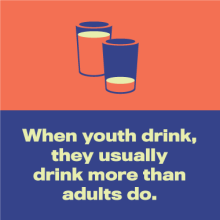Small Talks: Get the Facts on Underage Drinking
Underage drinking isn’t harmless fun. School-aged kids are going through a critical period of physical and emotional growth. Kids who drink alcohol during this time expose their developing brains, lives, and mental health to serious, even deadly, consequences. Help the kids in your life understand the risks of underage drinking by getting the facts for yourself.
Why kids drink
Underage drinking isn’t a rite of passage. It’s not just curiosity or bad behavior, either. It is a community-wide challenge that affects Wisconsin families of all shapes and sizes. There are many reasons why children try alcohol, from peer pressure to unregulated marketing tactics. Kids may see it as a way to cope with trauma or difficulties in school, at home or in their community. No matter what, families aren’t to blame for underage drinking.
Signs of underage drinking
Kids go through many physical, emotional, and social changes as they grow. It’s a natural part of adolescence that can make it hard to recognize when a kid is at risk for underage drinking or already drinking alcohol. That’s why it’s important to look out for the following changes in attitudes and behaviors that could indicate a more serious problem.
- Big mood swings and/or a defensive attitude.
- Problems at school, like falling grades or poor attendance.
- Breaking family rules.
- Getting rid of old friends or not introducing you to new ones.
- A lack of interest in their appearance or favorite activities.
- Memory lapses and poor concentration or coordination.
- The smell of alcohol.
- Slurred speech.
- Hangover symptoms, like bloodshot eyes.
- Alcohol missing from your home.
- Finding alcohol in hidden places, like a closet or backpack.
- Hanging out with friends that use alcohol or other substances.
How kids get their hands on alcohol
For most kids, underage drinking usually happens at home or a friend’s house. But how kids get alcohol can change as they grow, and often depends on their age and how accessible beer, liquor, and other beverages are where they live and hang out.
- They sneak it. Two out of three teens say it’s easy to take alcohol from home without a caregiver noticing. Unlocked liquor cabinets and beer fridges don’t help.
- They buy it. A quarter (25%) of 11th grade drinkers admit to buying alcohol from a retailer, like a gas station or grocery, liquor, or convenience store.
- They ask for it. Often, older friends, siblings, and parents supply kids with alcohol. In fact, one in four teens report that they have attended a party where kids drank in front of adults.
Know the consequences
There’s a reason the legal drinking age is 21. It’s to keep our kids healthy and safe.
Alcohol affects young people more powerfully than it does adults, and drinking before the brain and body are fully developed can have dangerous effects.
- Underage drinking can change the way the brain develops and functions.
- Alcohol can shut down new brain cell growth.
- Drinking can damage the parts of the brain responsible for learning, memory, and self-control.
- Alcohol can alter a child’s motor skills.
- High levels of alcohol in the body can shut down those parts of the brain that control breathing, heart rate, and body temperature.
- Heavy alcohol use can increase the risk of liver disease and heart disease.
- Heavy alcohol use can also increase the risk of seven different cancers later in life. Learn more from the Wisconsin Cancer Collaborative.
Underage drinking has serious consequences for a young person’s life, affecting everything from their behavior and relationships to their long-term health.
- Fifteen percent of kids who drink have been in a car with a driver who’d been drinking alcohol.
- There’s always a risk that substance use may lead to addiction.
- Drinking can lead to issues at school, with friends, and with the law.
- In the U.S., alcohol landed 147,000 underage drinkers in emergency rooms in 2021 alone.
- Underage drinking is associated with a higher risk of physical and sexual assault.
As young people transition from childhood to adolescence, they experience dramatic social and emotional changes. Adding alcohol to the mix can be devastating.
- Underage drinking often goes hand-in-hand with higher rates of depression, anxiety, and suicide.
- Research shows that waiting to start drinking alcohol is one of the most effective ways to prevent the development of a substance use disorder later in life.
- Underage alcohol use is associated with kids who struggle with mental illness.
Loosely defined as having four or five drinks in just two hours, binge drinking is especially dangerous for kids.
- Around 90% of underage drinking is binge drinking.
- Because most underage drinking is binge drinking, young people are more likely to experience alcohol poisoning.
- Kids don’t drink as often as adults do, but when they have access to alcohol, they usually drink more than an adult would.
- Binge drinking lowers inhibitions at a time when young people are already eager to take risks.
Helpful resources
Start your next small talk about alcohol and its effects with confidence. Download our helpful handouts for the latest information on underage drinking.
- Help any kid understand the consequences of underage drinking: Give them 3 fast facts (PDF)
- Alcohol, kids, and cancer: Making the connection (PDF)
The DHS Alcohol Use: Youth Population data dashboard shows the latest statistics on underage drinking in Wisconsin.
You can do this
Having casual conversations with the kids in your life about underage drinking is easier than you think. We can show you how to get started.




